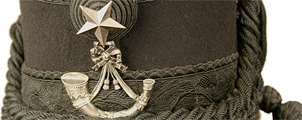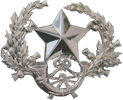British Army ration biscuits
Army issue biscuits or ‘hard tack’ have been a staple part of ration packs throughout the history of the British Army. Within our collections at South Lanarkshire Leisure and Culture we have three such biscuits. One is wrapped in the pages of The Glasgow Herald dated 13th October 1900 and dates from the Boer War. The second dates from the early 20th century, most likely from the First World War and the third is from the Second World War.
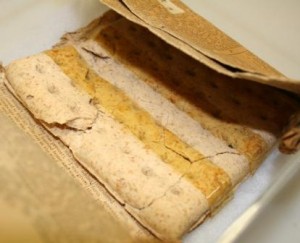
Ration biscuit from the Boer War wrapped in pages of The Glasgow Herald dated 13th October 1900.
During the First World War British troops consumed approximately 4,500 calories a day. Whilst this sounds a substantial amount, food at the front was often poor quality and rations could be sporadic. Feeding an army was logistically, a complex task. Supply lines were often affected by fighting and shortages were prevalent. By the end of First World War there were over 2.3million men at the Western Front alone. The food supplied was often monotonous and at times inedible, however, in comparison to French and German troops, the British were believed to have been relatively well fed.
There was no official standard army ration during the First World War but all men received roughly the same allowance. Colonel H.H. Story M.C. states in The History of the Cameronians (Scottish Rifles) 1910-1933 that the rations issued to the 19th Infantry Brigade during the winter of 1914-15 were as follows,
Bread/Biscuit: 1lb
Meat: 12oz
Vegetables: 8oz
Bacon: 4oz
Sugar: 3oz
Jam: 4oz
Butter/marg: 2oz
Cheese: 3oz
These were issued daily with the exception of butter which soldiers received twice a week. Meat was usually tinned known as ‘Bully beef’ or issued as the infamous ‘Maconochie,’ a mixture of fatty meat, vegetables and gravy. The food often had to be eaten cold and the men had to prepare their meals themselves whilst at the front. Bread was scarce, particularly in 1916 when there was a flour shortage. Men often had to resort to ‘biscuits’ made from salt, flour and water. In 1914 Huntley and Palmers were contracted by the British government to produce the No.4 standard Army Biscuit, so called as it was approximately 4 inches square. At the time Huntley and Palmers were the world’s biggest biscuit manufacturer and had even supplied Captain Scott with biscuits on his expedition to the Antarctic in 1911.
These ‘hard tack army biscuits’ were incredibly tough and often had to be soaked in tea or water for some time before consumption. Sometimes they were ground down to use as a thickening agent (known as ‘duff’) for stews. Other men found more novel uses for the humble but durable biscuit. Some used them as postcards by writing messages on the surface and posting them home to arrive at their destination intact. Others used them as a blank canvas to paint or draw on, but perhaps one of the most popular uses was as a photo frame. The frame was created by carving out the centre and placing a photograph in the hollow.
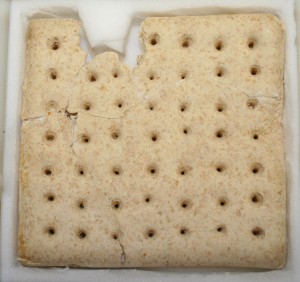
Biscuit from the early 20th century, possibly First World War 1914-18.
Whilst many found humour in the hard tack biscuits others were angered by the poor quality food that they received. One biscuit in the collections of the Imperial War Museum, North bares the handwritten message, “YOUR KING AND COUNTRY NEED YOU AND THIS IS HOW THEY FEED YOU.”
The fact that so many of these biscuits survive today, 100 years after their production, is testament to their durability and perhaps the incredulity of many men who kept these biscuits not only as mementos but as physical evidence of the diet that they were subjected to.
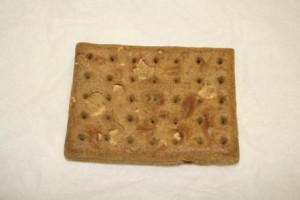
Iron ration biscuit from the Second World War 1939-1945.
Comments:
Quintinshill Rail Disaster and the road to Gallipoli
Today marks the 100th anniversary of the Quintinshill train crash in which over 200 soldiers of the 1/7th Royal Scots were killed. It remains, to this day, Britain’s worst rail disaster. The soldiers involved were en route to Liverpool, where they were to embark ships headed for Gallipoli. The 1/7th Royal Scots were one of several battalions of the 52nd (Lowland) Division bound for Gallipoli. The 1/7th Scottish Rifles travelled from Falkirk to Liverpool on 22nd May, while the 1/8th Scottish Rifles were already at sea headed for the Dardanelles.
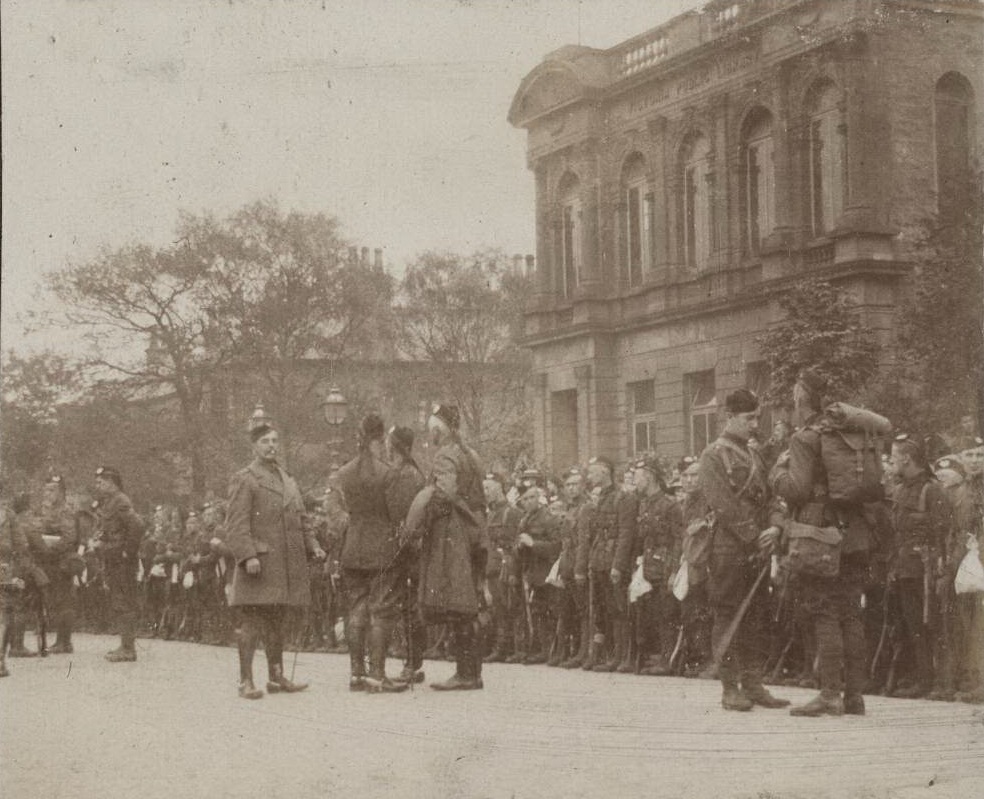
Men of the 1/7th Scottish Rifles parading in front of Grangemouth Public Library, 21st May 1915.
News of the train crash reached the men of the Scottish Rifles as they were embarking on the ships to take them to Gallipoli. Captain Maclean of the 1/7th Scottish Rifles recalls:
“…rumours began to circulate that some of the troops belonging to the division had been involved in a serious railway accident and this news proved only too tragically true. A train containing two companies of the 7th Royal Scots had collided with a local train near Gretna, while within a minute of this catastrophe the north-bound London express had crashed into the wreckage of the troop-train. In a very few minutes fire had got a firm hold on the telescoped carriages, and in spite of every effort to save them, many of the imprisoned victims perished in the flames. The losses of the Royal Scots in this disaster, the worst in the history of British railways, were 3 officers and 207 other ranks, while the survivors were naturally so badly shaken that the War Office deemed it advisable to send them back to their homes”
The 1/7th Scottish Rifles embarked on board the SS Empress of Britain on 22nd May 1915, setting out of the following evening at 7:30pm – their destination, the Gallipoli peninsula.
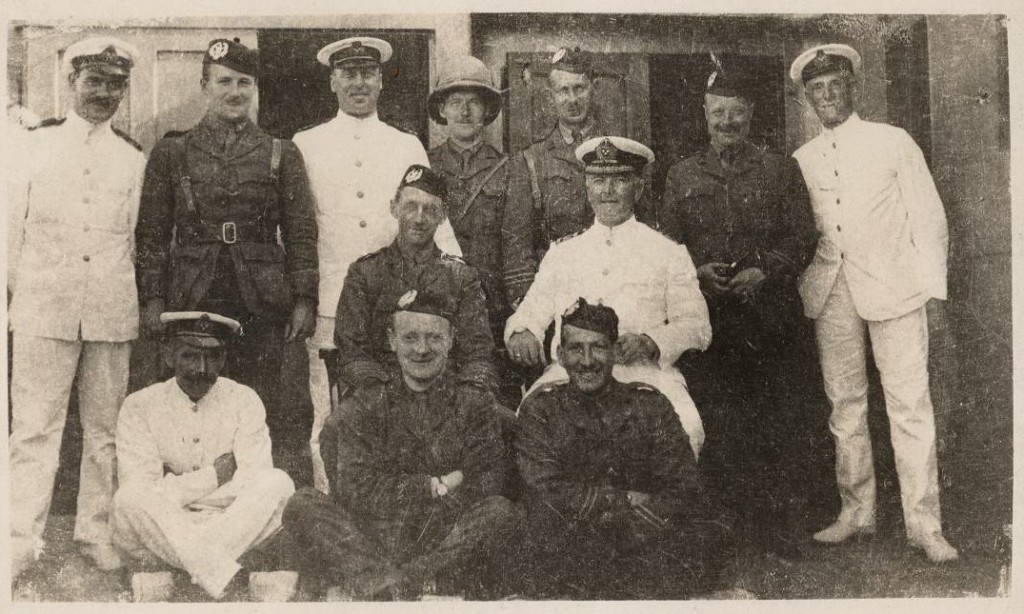
Officers of the 1/7th Scottish Rifles pose with the crew on board SS Empress of Britain
In little over a month’s time, both the 1/7th and 1/8th Scottish Rifles would take part in the attack at Gully Ravine, which would turn out to be one of the Regiment’s bloodiest actions of the First World War.
Comments:
Posted: 22/05/2015 by BarrieDuncan in First World War
Gallipoli Centenary Education Project
‘From the moment a man arrives on the Gallipoli peninsula till he leaves again
he is within range of shellfire no matter where he goes’
Extract from a diary written by Pts Chas R Bow 7th Battalion, The Cameronians (Scottish Rifles)
Gallipoli was one of the most controversial and bloodiest campaigns for the First World War.
Over 500,000 Allied troops fought on this campaign including the 7th and 8th battalions of The Cameronians.
This was to become one of the many battle grounds etched into the history of the regiment.
We’re about to begin our part of the Gallipoli Centenary Education Project, an exciting HLF funded national and international schools education project, which has the potential to create pioneering online learning resources principally designed for and by schools. Centred on the stories of individual soldiers, as well as giving the opportunity to look at how this campaign is viewed by other partner organisations and nations, we hope to help give new perspectives to the campaign from both sides.
The lead partner is the highly respected Gallipoli Association. http://www.gallipoli-association.org/
Over the coming months we will keep you up to date with how our part of the project is progressing. Giving you links to the stories and research the schools have uncovered from not only our own regimental collections, but also the work and stories being produced by all the partner organisations.
The new website for the project has just been launched; http://www.gallipoli100education.org.uk/
You can also follow the project on twitter. https://twitter.com/GallipoliEd
Comments:
Private James Towers VC
The Victoria Cross medal group to Private James Towers VC, 2nd Battalion The Cameronians (Scottish Rifles), sold at auction yesterday (Wed 25th March) with a hammer price of £120,000. Private Towers was the last of three soldiers of the Regiment to be awarded the Victoria Cross for service in the First World War, and was in fact the last Cameronian to earn the famous award.
The war diary of the 2nd Battalion for 22nd December 1918 reads:
“One of the greatest days in the history of the Battalion. At about 10.00 hrs a wire came in stating that the VICTORIA CROSS had been awarded to PTE. JAMES TOWERS of B Company for an Act of the most unsurpassed bravery performed by him on the 6th Oct. this year.”
We are fortunate to have in the museum collection the very signal that was received that day notifying the Battalion of the award of the VC to Private Towers. The signal was taken by Private Harry Podmore, one of the Battalion signallers, and was kept by him as a souvenir. At some point, Private Towers has signed the signal ‘Pte. J. Towers V.C.’
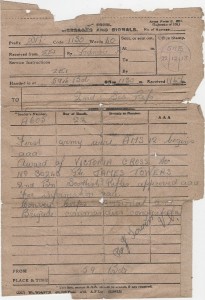
Signal Message, 2nd Battalion Scottish Rifles, dated 22nd December 1918
The war diary for that day continues:
“The Pipe Band were paraded and played PTE TOWERS from Battalion Hdqrs through the village to his billet. He was carried shoulder high by a party of his own platoon & received a great ovation from the whole Battalion.”
With the fighting only ending a matter of weeks earlier, on 11th November, the men truly had reason to celebrate news of the award.
You can browse and search for more fascinating objects in the museum collection by using our online Collections Browser – http://www.slleisureandculture.co.uk/SLLC/info/206/online_collection
Comments:
Christmas in the trenches with The Cameronians (Scottish Rifles)
As we commemorate the 100 year centenary of the First World War the collections team here at South Lanarkshire Leisure and Culture have been sorting through all the objects and archive we have relating to the First World War. During this process we have come across a number of poignant and interesting objects relating to Christmas in the trenches.
For most soldiers Christmas Day in a theatre of war would be like any other day perhaps with the added bonus of a few extra cigarettes or cakes to share amongst them. December 1914 in France also saw very cold, wet and muddy conditions so men would have struggled to stay dry and warm for long. These photographs from the museum collection show officers of the 1st and 5th Battalions in the trenches on Christmas Day 1914 with Captain T. R. McLellan playing the bagpipes for the men and Private Coghlan doing his best to cheer up the men by dressing up.
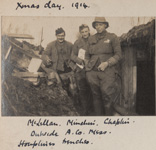
Christmas day in the trenches

McLellan final image

Rfn Coghlan final
There has been much mention recently of the Christmas Truce of 1914, when soldiers of the British Army and German Armies observed a truce for Christmas Day and met in no-man’s land to exchange gifts and play football. The truce was not observed everywhere along the Western Front and fighting continued in many places. Extracts from the war diaries, which have been fully transcribed by our volunteers, The Friends of Low Parks Museum, show that of the three battalions of The Cameronians who were out in France by December 1914, the 1st and 2nd Battalions carried on as normal. The 1st Battalion reported: “Enemy very noisy during night. One man wounded.” The 5th Battalion however reported: “Very little sniping, almost an understanding not to fire but one man killed by a sniper”. The 5th Battalion History book elaborates on this saying:
“On Christmas Eve we could hear the Germans (XIXth Saxon Corps) celebrating the advent of Christmas by singing and merrymaking. We could also hear a brass band behind the houses in their lines playing Christmas carols. For roughly twenty-four hours, Christmas Eve to late afternoon on Christmas day, they ceased firing at us, and we reciprocated. An attempt at fraternisation took place on Christmas day, ” Jerry ” leaving his trench unarmed. Certain souvenirs were exchanged and, if it had been left to the soldiery of both sides, the war would there and then have been declared a draw. But towards late afternoon on Christmas day a stray shot from our right front hit one of ours, No. 6 I 79, Corpl. W. S. Smith, No. 2 Company (from which he died next day). The Saxons opposite us were at pains to let us know that it was a Prussian who had fired the shot which killed Smith. This broke the spell, however, and the war was resumed after a tacit truce of twenty four hours. This truce drew forth an army routine order reminding us that we ‘were in France to fight and not to fraternise with the enemy.”
Christmas could be a lonely time for soldiers when thoughts would turn to loved ones at home. Friends and families would send letters and parcels to the men at the front and often soldiers would send embroidered postcards like the one below to their beloved.

Christmas embroidered postcard final
We recently came across the postcard below in the collection. Writing home to the daughter he has yet to meet, Rifleman Davidson wishes her a “merry merry Christmas…and a merrier and prosperous New Year.” Unfortunately we have been unable to track down exactly who Rfn Davidson was and if he did indeed survive to meet his new daughter. If you have any information which could help us with this then please do let us know.

Rfn W Davidson Xmas Card front final

Rfn W Davidson Xmas Card back final
Comments:
Log in
